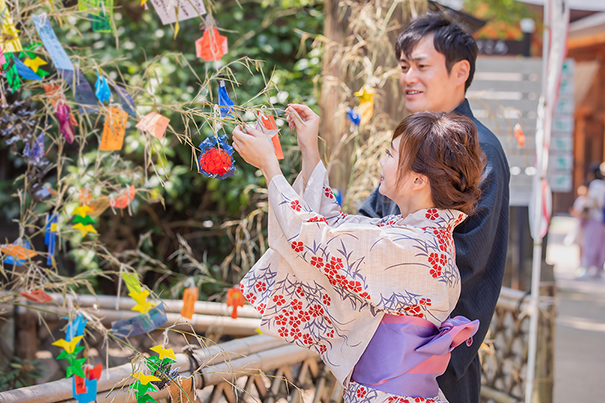Japan’s rich cultural traditions are interwoven with numerous festivals, each celebrating the changing seasons, historical events, and mythical tales. Among these, the Tanabata Festival, also known as the Star Festival, stands out as a unique celebration of love, wishes, and the beauty of the night sky. Tanabata is a cherished event that captures the imagination with its romantic legend and vibrant festivities. For tourists visiting Japan, experiencing Tanabata offers a magical glimpse into the country’s mythological and cultural heritage.

The Legend of Tanabata
Tanabata’s origins are rooted in an ancient Chinese legend introduced to Japan during the Nara period (710–794). The story revolves around two star-crossed lovers: Orihime, the weaving princess represented by the star Vega, and Hikoboshi, the cowherd represented by the star Altair.
According to the legend, Orihime, the daughter of the Sky King (Tentei), was a talented weaver who created beautiful cloth by the banks of the Amanogawa (Milky Way). Her father arranged for her to marry Hikoboshi, a diligent cowherd who lived on the other side of the Milky Way. However, after their marriage, Orihime and Hikoboshi became so enamoured with each other that they neglected their duties. This angered Tentei, who separated the lovers by the Milky Way, allowing them to meet only once a year on the seventh day of the seventh month.
This annual reunion became the basis for Tanabata, celebrating the power of love and the hope that wishes will be fulfilled. The stars Vega and Altair’s appearance in the night sky during summer adds a celestial charm to the celebration.
The Importance of Tanabata to Locals
Tanabata holds significant cultural importance in Japan. It is a time when people reflect on the themes of love, perseverance, and hope. The festival is also a period of community bonding, where towns and cities come alive with decorations, parades, and various events. The act of writing wishes on colourful strips of paper, known as tanzaku, and hanging them on bamboo branches symbolises the collective hopes and dreams of the community.
For many Japanese people, Tanabata is a reminder of the importance of hard work and dedication, as illustrated by Orihime and Hikoboshi’s story. It encourages individuals to cherish their loved ones and strive for balance in their personal and professional lives.
Celebrating Tanabata: Traditions and Activities
Tanabata is celebrated across Japan, with each region adding its unique flair to the festivities. Several common elements can be found in Tanabata celebrations nationwide:
1. Tanzaku and Bamboo Trees:
Writing wishes on tanzaku is one of the most iconic Tanabata traditions. These colourful strips of paper are inscribed with personal desires, prayers, or poems and then hung on bamboo branches. The bamboo trees, adorned with tanzaku and other ornaments, create a stunning display of colours and aspirations. It is believed that if the wishes are written with sincerity, they will come true.
2. Tanabata Decorations:
Various decorations are used to celebrate Tanabata, including paper streamers (fukinagashi) representing the weaving of threads, paper cranes (orizuru) symbolising longevity, and other intricate paper crafts. Streets, shopping arcades, and homes are often decorated with these vibrant ornaments.
3. Festivals and Parades:
Many cities host large-scale Tanabata festivals featuring parades, traditional music, dance performances, and fireworks. One of the most famous Tanabata festivals is held in Sendai, Miyagi Prefecture, where thousands of colourful streamers line the streets, creating a breathtaking visual spectacle. The festival in Hiratsuka, Kanagawa Prefecture, is also well-known for its grand scale and lively celebrations.
Experiencing Tanabata as a Tourist
For tourists, participating in Tanabata offers a unique and immersive cultural experience. Here are some ways to make the most of the festival:
1. Join Local Celebrations:
Visit regions known for their Tanabata festivals, such as Sendai or Hiratsuka, to experience the full scale of the festivities. These events often include parades, live performances, and beautifully decorated streets.
2. Write Your Own Tanzaku:
Engage in the tradition of writing wishes on tanzaku and hanging them on bamboo branches. Many shrines, temples, and public spaces set up tanzaku stations for visitors to participate in this custom.
3. Explore Traditional Markets:
Tanabata festivals often feature bustling markets with stalls selling food, souvenirs, and festival-related items. Exploring these markets allows tourists to sample local delicacies and purchase unique mementos.
Conclusion
The Tanabata Festival is a captivating celebration that brings together the elements of myth, love, and community spirit. Its enchanting legend of star-crossed lovers, combined with vibrant decorations and heartfelt wishes, creates a magical atmosphere that resonates deeply with both locals and visitors. For tourists, experiencing Tanabata is an opportunity to connect with Japan’s cultural heritage and participate in a festival that celebrates the beauty of dreams and the enduring power of love. Whether writing a wish on a tanzaku or marvelling at the star-filled sky, Tanabata offers a memorable and heartwarming journey into the heart of Japanese tradition.










